2009 BMW 328I XDRIVE SPORTS WAGON park assist
[x] Cancel search: park assistPage 82 of 268
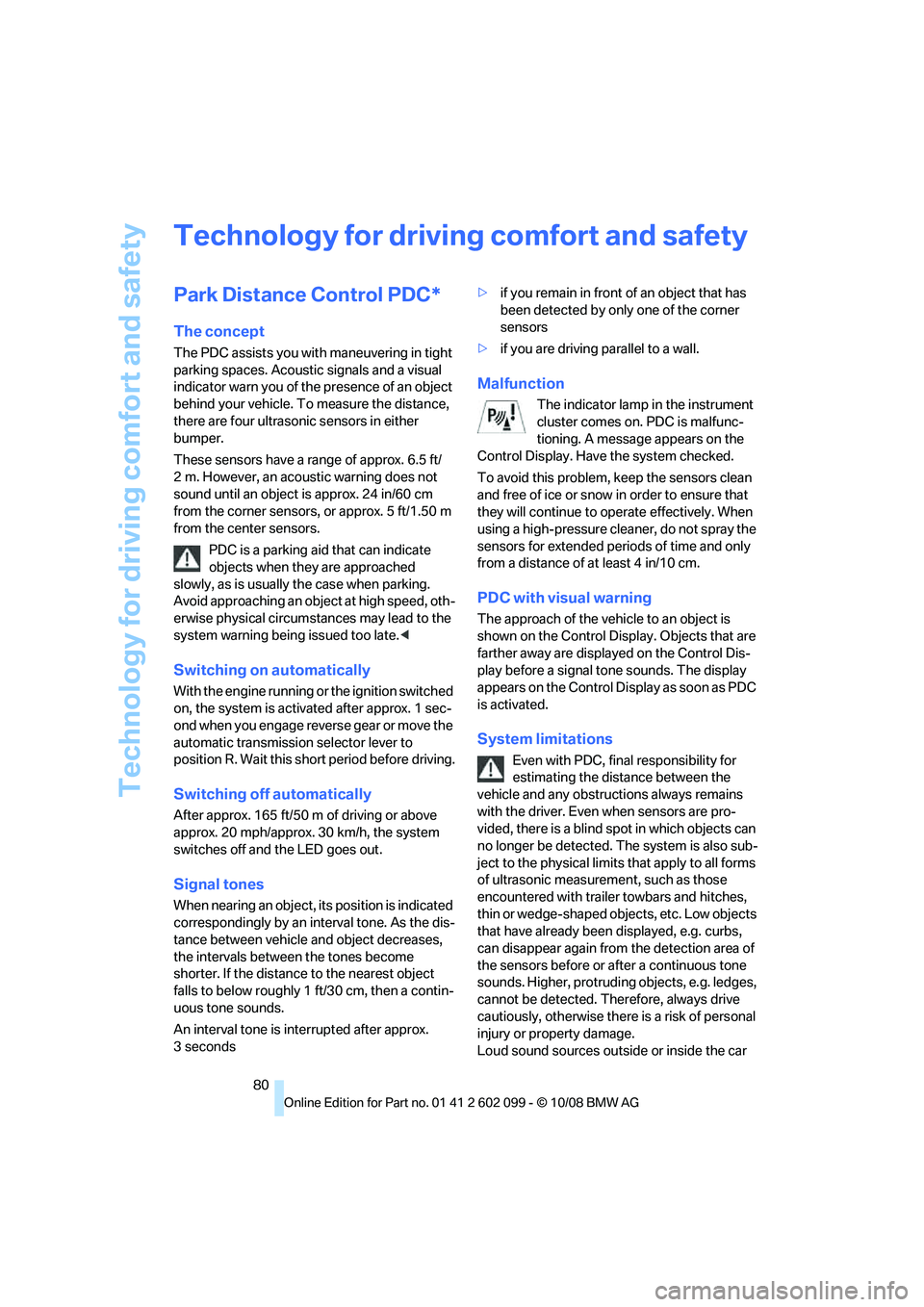
Technology for driving comfort and safety
80
Technology for driving comfort and safety
Park Distance Control PDC*
The concept
The PDC assists you with maneuvering in tight
parking spaces. Acoustic signals and a visual
indicator
warn you of the presence of an object
behind your vehicle. To measure the distance,
there are four ultrasonic sensors in either
bumper.
These sensors have a range of approx. 6.5 ft/
2 m. However, an acoustic warning does not
sound until an object is approx. 24 in/60 cm
from the corner sensors, or approx. 5 ft/1.50 m
from the center sensors.
PDC is a parking aid that can indicate
objects when they are approached
slowly, as is usually th e case when parking.
Avoid approaching an object at high speed, oth-
erwise physical circumstances may lead to the
system warning being issued too late. <
Switching on automatically
With the engine running or the ignition switched
on, the system is activated after approx. 1 sec-
ond when you engage reverse gear or move the
automatic transmission selector lever to
position R. Wait this short period before driving.
Switching off automatically
After approx. 165 ft/50 m of driving or above
approx. 20 mph/approx. 30 km/h, the system
switches off and the LED goes out.
Signal tones
When nearing an object, its position is indicated
correspondingly by an interval tone. As the dis-
tance between vehicle an d object decreases,
the intervals betwee n the tones become
shorter. If the distance to the nearest object
falls to below roughly 1 ft/30 cm, then a contin-
uous tone sounds.
An interval tone is interrupted after approx.
3seconds >
if you remain in front of an object that has
been detected by only one of the corner
sensors
> if you are driving parallel to a wall.
Malfunction
The indicator lamp in the instrument
cluster comes on. PDC is malfunc-
tioning. A message appears on the
Control Display. Have the system checked.
To avoid this problem, keep the sensors clean
and free of ice or snow in order to ensure that
they will continue to op erate effectively. When
using a high-pressure cleaner, do not spray the
sensors for extended periods of time and only
from a distance of at least 4 in/10 cm.
PDC with visual warning
The approach of the vehicle to an object is
shown on the Control Display. Objects that are
farther away are displayed on the Control Dis-
play before a signal to ne sounds. The display
appears on the Control Di splay as soon as PDC
is activated.
System limitations
Even with PDC, final responsibility for
estimating the distance between the
vehicle and any obstructions always remains
with the driver. Even when sensors are pro-
vided, there is a blind sp ot in which objects can
no longer be detected. The system is also sub-
ject to the physical limits that apply to all forms
of ultrasonic measurement, such as those
encountered with traile r towbars and hitches,
thin or wedge-shaped objects, etc. Low objects
that have already been displayed, e.g. curbs,
can disappear again from the detection area of
the sensors before or af ter a continuous tone
sounds. Higher, protruding objects, e.g. ledges,
cannot be detected. Therefore, always drive
cautiously, otherwise there is a risk of personal
injury or property damage.
Loud sound sources outside or inside the car
ba8_E9091_cic.book Seite 80 Mittwoch, 29. Oktober 2008 2:59 14
Page 85 of 268
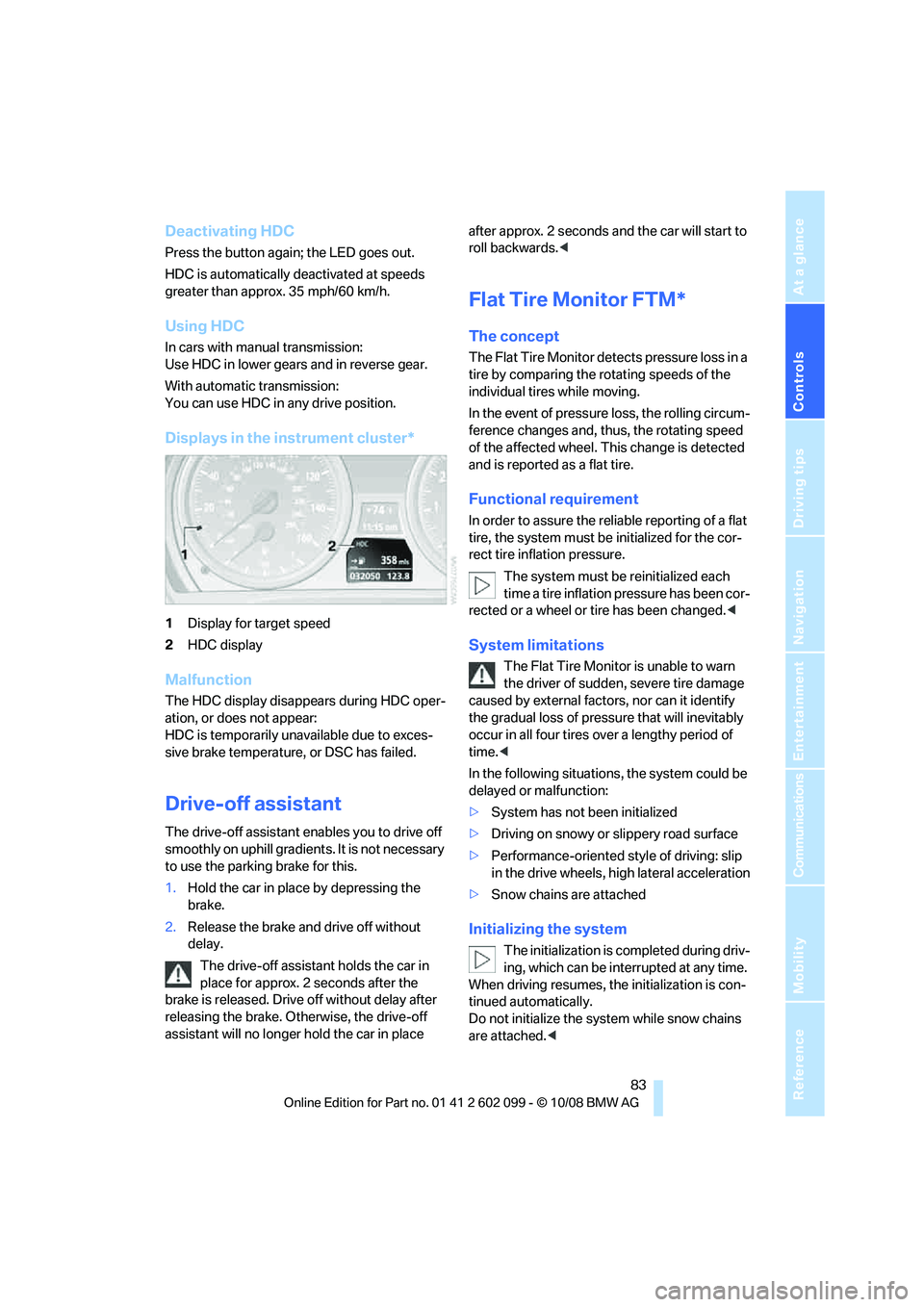
Controls
83Reference
At a glance
Driving tips
Communications
Navigation
Entertainment
Mobility
Deactivating HDC
Press the button again; the LED goes out.
HDC is automatically deactivated at speeds
greater than approx. 35 mph/60 km/h.
Using HDC
In cars with manual transmission:
Use HDC in lower gears and in reverse gear.
With automatic transmission:
You can use HDC in any drive position.
Displays in the instrument cluster*
1 Display for target speed
2 HDC display
Malfunction
The HDC display disappears during HDC oper-
ation, or does not appear:
HDC is temporarily unav ailable due to exces-
sive brake temperature, or DSC has failed.
Drive-off assistant
The drive-off assistant enables you to drive off
smoothly on uphill gradient s. It is not necessary
to use the parking brake for this.
1. Hold the car in place by depressing the
brake.
2. Release the brake and drive off without
delay.
The drive-off assistant holds the car in
place for approx. 2 seconds after the
brake is released. Drive off without delay after
releasing the brake. Otherwise, the drive-off
assistant will no longer hold the car in place after approx. 2 seconds an
d the car will start to
roll backwards. <
Flat Tire Monitor FTM*
The concept
The Flat Tire Monitor detects pressure loss in a
tire by comparing the rotating speeds of the
individual tires while moving.
In the event of pressure loss, the rolling circum-
ference changes and, thus, the rotating speed
of the affected wheel. This change is detected
and is reported as a flat tire.
Functional requirement
In order to assure the reliable reporting of a flat
tire, the system must be initialized for the cor-
rect tire inflation pressure.
The system must be reinitialized each
time a tire inflation pressure has been cor-
rected or a wheel or tire has been changed. <
System limitations
The Flat Tire Monitor is unable to warn
the driver of sudden, severe tire damage
caused by external factors, nor can it identify
the gradual loss of pressure that will inevitably
occur in all four tires over a lengthy period of
time. <
In the following situations, the system could be
delayed or malfunction:
> System has not been initialized
> Driving on snowy or slippery road surface
> Performance-oriented style of driving: slip
in the drive wheels, hi gh lateral acceleration
> Snow chains are attached
Initializing the system
The initialization is completed during driv-
ing, which can be interrupted at any time.
When driving resumes, the initialization is con-
tinued automatically.
Do not initialize the syst em while snow chains
are attached. <
ba8_E9091_cic.book Seite 83 Mittwoch, 29. Oktober 2008 2:59 14
Page 118 of 268
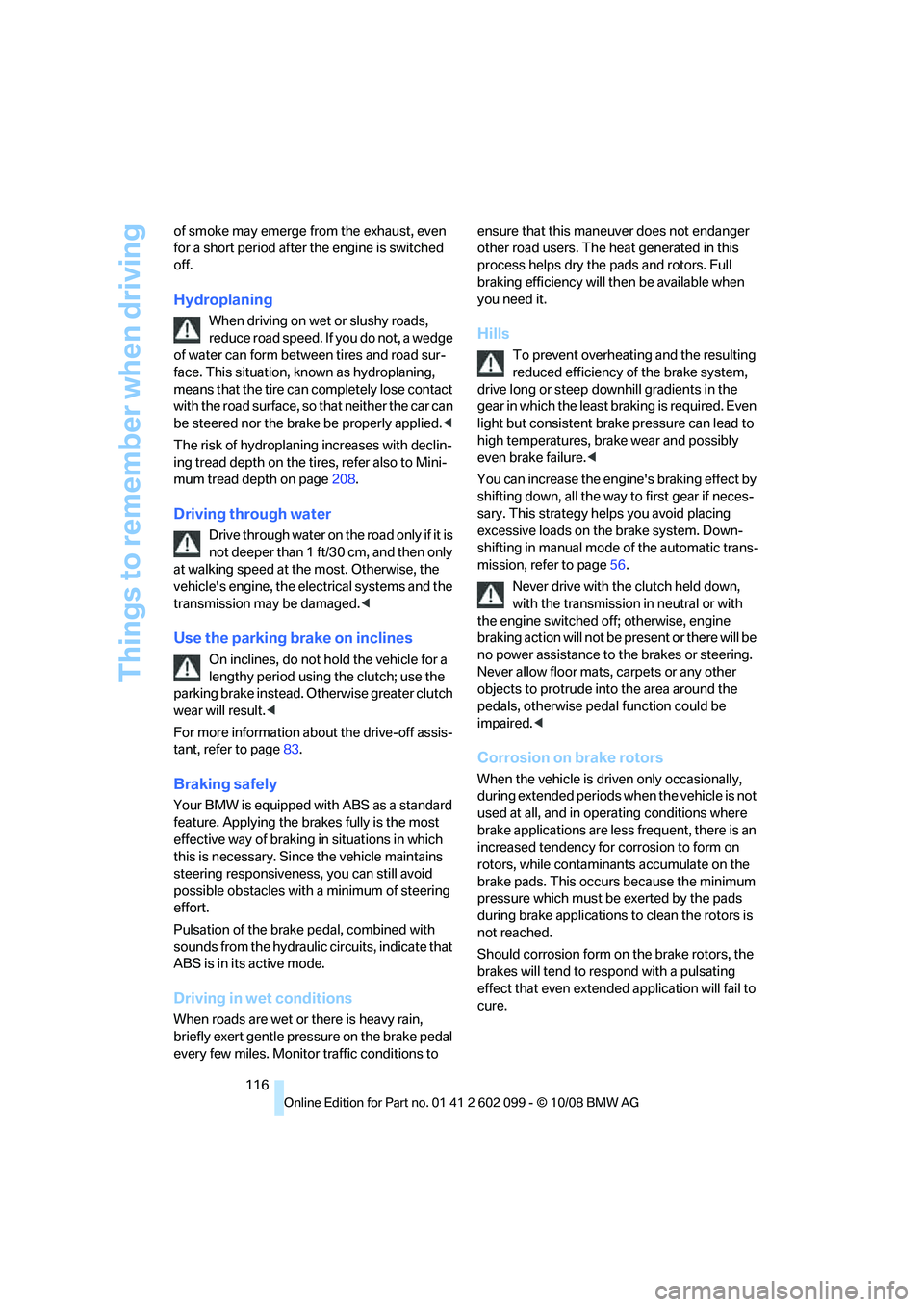
Things to remember when driving
116
of smoke may emerge from the exhaust, even
for a short period after
the engine is switched
off.
Hydroplaning
When driving on wet or slushy roads,
reduce road speed. If you do not, a wedge
of water can form between tires and road sur-
face. This situation, known as hydroplaning,
means that the tire can completely lose contact
with the road surface, so that neither the car can
be steered nor the brak e be properly applied.<
The risk of hydroplaning increases with declin-
ing tread depth on the tire s, refer also to Mini-
mum tread depth on page 208.
Driving through water
Drive through water on the road only if it is
not deeper than 1 ft/30 cm, and then only
at walking speed at the most. Otherwise, the
vehicle's engine, the electrical systems and the
transmission may be damaged. <
Use the parking brake on inclines
On inclines, do not hold the vehicle for a
lengthy period using the clutch; use the
parking brake instead. Ot herwise greater clutch
wear will result. <
For more information about the drive-off assis-
tant, refer to page 83.
Braking safely
Your BMW is equipped with ABS as a standard
feature. Applying the brakes fully is the most
effective way of braking in situations in which
this is necessary. Since the vehicle maintains
steering responsiveness, you can still avoid
possible obstacles with a minimum of steering
effort.
Pulsation of the brake pedal, combined with
sounds from the hydraulic circuits, indicate that
ABS is in its active mode.
Driving in wet conditions
When roads are wet or there is heavy rain,
briefly exert gentle pre ssure on the brake pedal
every few miles. Monitor traffic conditions to ensure that this maneuver does not endanger
other road users. The heat generated in this
process helps dry the pads and rotors. Full
braking efficiency will th
en be available when
you need it.
Hills
To prevent overheating and the resulting
reduced efficiency of the brake system,
drive long or steep downhill gradients in the
gear in which the least br aking is required. Even
light but consistent brak e pressure can lead to
high temperatures, brake wear and possibly
even brake failure. <
You can increase the engine's braking effect by
shifting down, all the way to first gear if neces-
sary. This strategy helps you avoid placing
excessive loads on the brake system. Down-
shifting in manual mode of the automatic trans-
mission, refer to page 56.
Never drive with the clutch held down,
with the transmission in neutral or with
the engine switched off; otherwise, engine
braking action will not be present or there will be
no power assistance to the brakes or steering.
Never allow floor mats, carpets or any other
objects to protrude into the area around the
pedals, otherwise peda l function could be
impaired. <
Corrosion on brake rotors
When the vehicle is driv en only occasionally,
during extended periods when the vehicle is not
used at all, and in op erating conditions where
brake applications are less frequent, there is an
increased tendency for corrosion to form on
rotors, while contaminan ts accumulate on the
brake pads. This occurs because the minimum
pressure which must be exerted by the pads
during brake applications to clean the rotors is
not reached.
Should corrosion form on the brake rotors, the
brakes will tend to re spond with a pulsating
effect that even extended application will fail to
cure.
ba8_E9091_cic.book Seite 116 Mittwoch, 29. Oktober 2008 2:59 14
Page 184 of 268
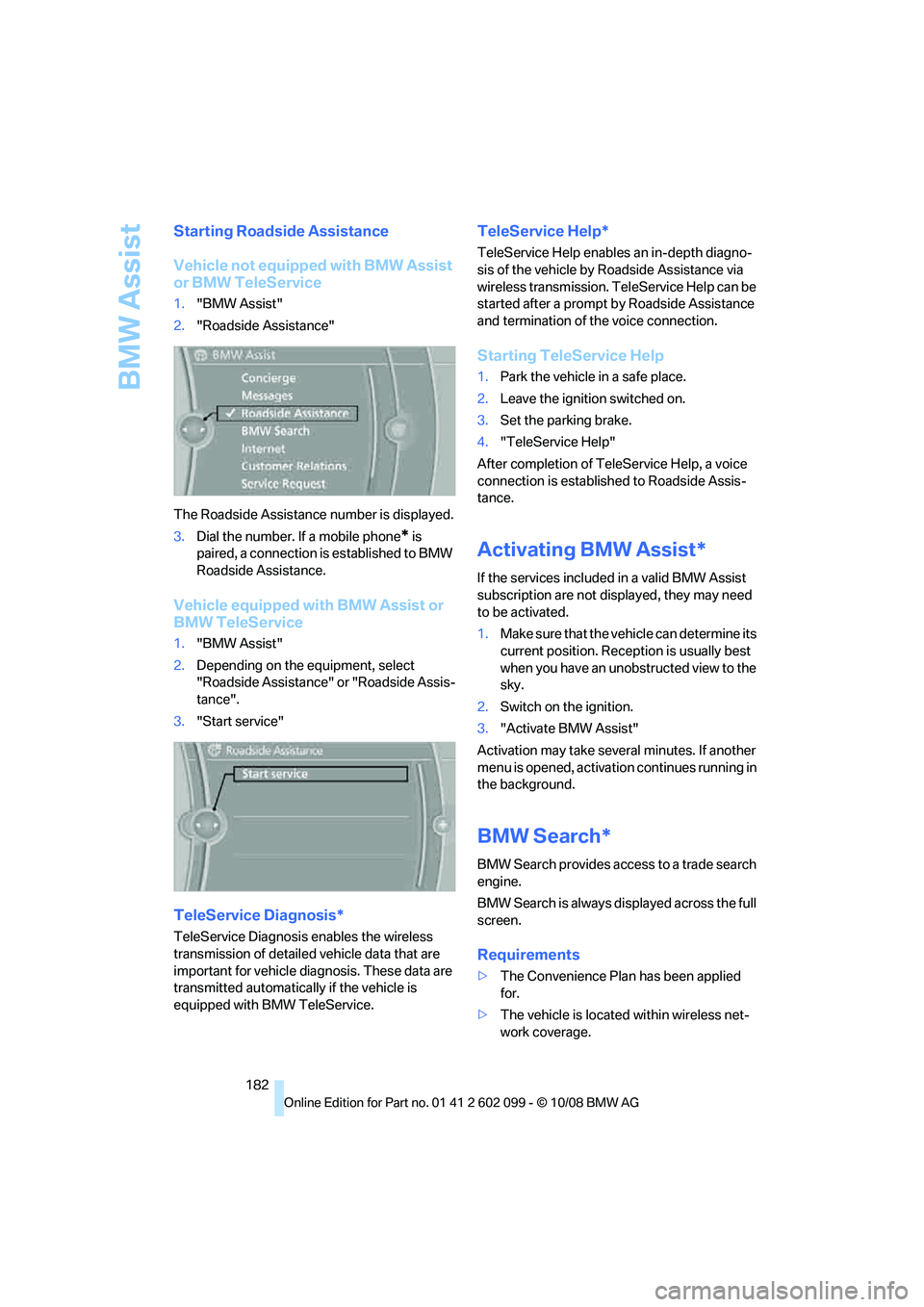
BMW Assist
182
Starting Roadside Assistance
Vehicle not equipped with BMW Assist
or BMW TeleService
1."BMW Assist"
2. "Roadside Assistance"
The Roadside Assistance number is displayed.
3. Dial the number. If a mobile phone
* is
paired, a connection is established to BMW
Roadside Assistance.
Vehicle equipped with BMW Assist or
BMW TeleService
1. "BMW Assist"
2. Depending on the equipment, select
"Roadside Assistance" or "Roadside Assis-
tance".
3. "Start service"
TeleService Diagnosis*
TeleService Diagnosis enables the wireless
transmission of detailed vehicle data that are
important for vehicle diagnosis. These data are
transmitted automatically if the vehicle is
equipped with BMW TeleService.
TeleService Help*
TeleService Help enables an in-depth diagno-
sis of the vehicle by Roadside Assistance via
wireless transmission. Te leService Help can be
started after a prompt by Roadside Assistance
and termination of the voice connection.
Starting TeleService Help
1. Park the vehicle in a safe place.
2. Leave the ignition switched on.
3. Set the parking brake.
4. "TeleService Help"
After completion of Te leService Help, a voice
connection is establishe d to Roadside Assis-
tance.
Activating BMW Assist*
If the services included in a valid BMW Assist
subscription are not disp layed, they may need
to be activated.
1. Make sure that the vehicle can determine its
current position. Recept ion is usually best
when you have an unobstructed view to the
sky.
2. Switch on the ignition.
3. "Activate BMW Assist"
Activation may take seve ral minutes. If another
menu is opened, activation continues running in
the background.
BMW Search*
BMW Search provides access to a trade search
engine.
BMW Search is always displayed across the full
screen.
Requirements
> The Convenience Plan has been applied
for.
> The vehicle is locate d within wireless net-
work coverage.
ba8_E9091_cic.book Seite 182 Mittwoch, 29. Oktober 2008 2:59 14
Page 234 of 268
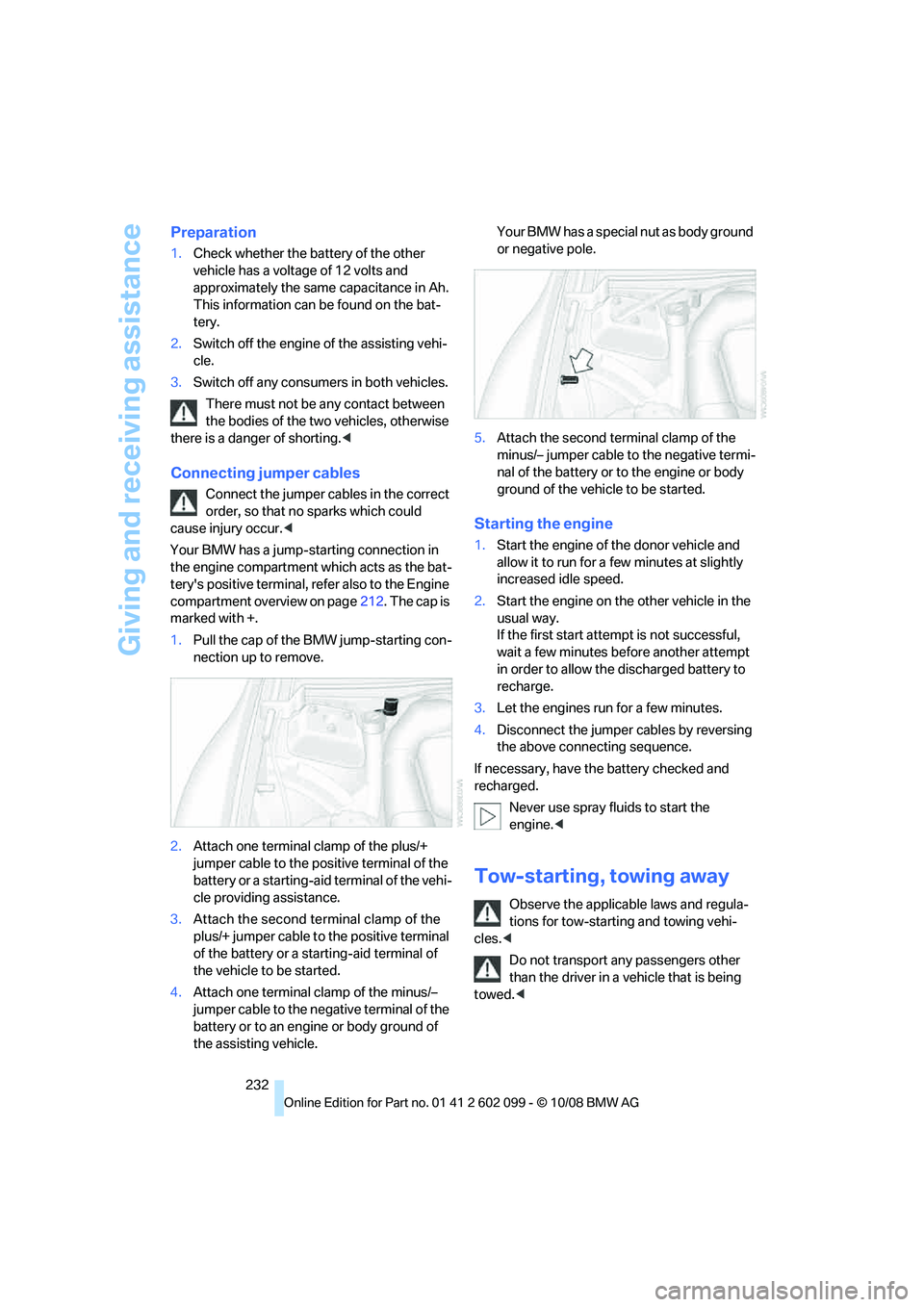
Giving and receiving assistance
232
Preparation
1.Check whether the battery of the other
vehicle has a voltage of 12 volts and
approximately the same capacitance in Ah.
This information can be found on the bat-
tery.
2. Switch off the engine of the assisting vehi-
cle.
3. Switch off any consumers in both vehicles.
There must not be any contact between
the bodies of the two vehicles, otherwise
there is a danger of shorting. <
Connecting jumper cables
Connect the jumper cables in the correct
order, so that no sparks which could
cause injury occur. <
Your BMW has a jump-starting connection in
the engine compartment which acts as the bat-
tery's positive terminal, refer also to the Engine
compartment overview on page 212. The cap is
marked with +.
1. Pull the cap of the BMW jump-starting con-
nection up to remove.
2. Attach one terminal clamp of the plus/+
jumper cable to the positive terminal of the
battery or a starting-aid terminal of the vehi-
cle providing assistance.
3. Attach the second terminal clamp of the
plus/+ jumper cable to the positive terminal
of the battery or a starting-aid terminal of
the vehicle to be started.
4. Attach one terminal clamp of the minus/–
jumper cable to the nega tive terminal of the
battery or to an engine or body ground of
the assisting vehicle. Your BMW has a special nut as body ground
or negative pole.
5. Attach the second te rminal clamp of the
minus/– jumper cable to the negative termi-
nal of the battery or to the engine or body
ground of the vehicle to be started.
Starting the engine
1. Start the engine of the donor vehicle and
allow it to run for a fe w minutes at slightly
increased idle speed.
2. Start the engine on the other vehicle in the
usual way.
If the first start attempt is not successful,
wait a few minutes be fore another attempt
in order to allow the discharged battery to
recharge.
3. Let the engines run for a few minutes.
4. Disconnect the jumper cables by reversing
the above connecting sequence.
If necessary, have th e battery checked and
recharged.
Never use spray fluids to start the
engine. <
Tow-starting, towing away
Observe the applicable laws and regula-
tions for tow-starting and towing vehi-
cles. <
Do not transport any passengers other
than the driver in a vehicle that is being
towed. <
ba8_E9091_cic.book Seite 232 Mittwoch, 29. Oktober 2008 2:59 14
Page 253 of 268
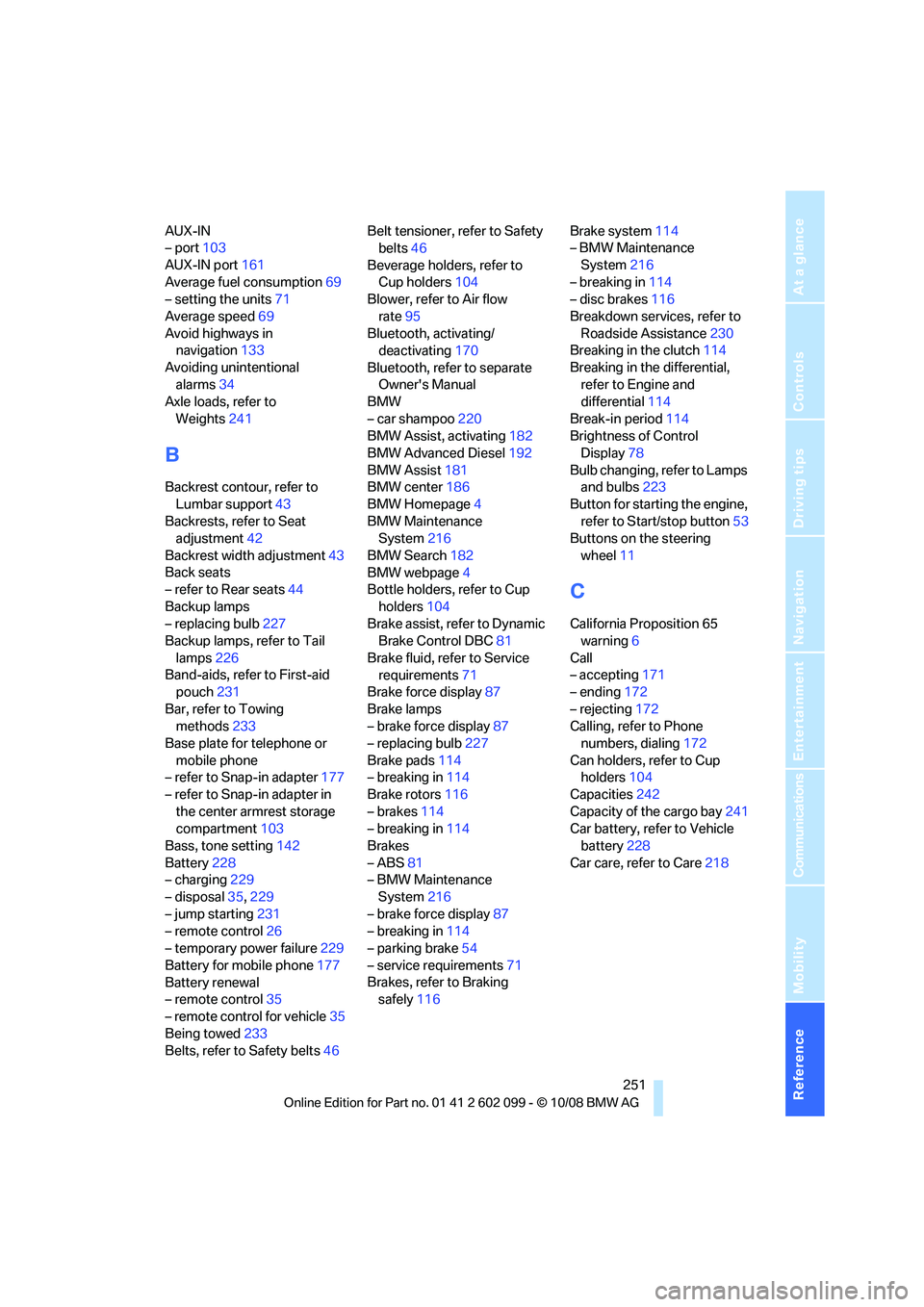
Reference 251
At a glance
Controls
Driving tips
Communications
Navigation
Entertainment
Mobility
AUX-IN
– port103
AUX-IN port 161
Average fuel consumption 69
– setting the units 71
Average speed 69
Avoid highways in navigation 133
Avoiding unintentional alarms 34
Axle loads, refer to
Weights 241
B
Backrest contour, refer to
Lumbar support 43
Backrests, refer to Seat adjustment 42
Backrest width adjustment 43
Back seats
– refer to Rear seats 44
Backup lamps
– replacing bulb 227
Backup lamps, refer to Tail
lamps 226
Band-aids, refer to First-aid pouch 231
Bar, refer to Towing methods 233
Base plate for telephone or
mobile phone
– refer to Snap-in adapter 177
– refer to Snap-in adapter in
the center armrest storage
compartment 103
Bass, tone setting 142
Battery 228
– charging 229
– disposal 35,229
– jump starting 231
– remote control 26
– temporary power failure 229
Battery for mobile phone 177
Battery renewal
– remote control 35
– remote control for vehicle 35
Being towed 233
Belts, refer to Safety belts 46Belt tensioner,
refer to Safety
belts 46
Beverage holders, refer to Cup holders 104
Blower, refer to Air flow
rate 95
Bluetooth, activating/ deactivating 170
Bluetooth, refer to separate Owner's Manual
BMW
– car shampoo 220
BMW Assist, activating 182
BMW Advanced Diesel 192
BMW Assist 181
BMW center 186
BMW Homepage 4
BMW Maintenance System 216
BMW Search 182
BMW webpage 4
Bottle holders, refer to Cup
holders 104
Brake assist, refer to Dynamic Brake Control DBC 81
Brake fluid, refer to Service requirements 71
Brake force display 87
Br
ake lamps
– brake force display 87
– replacing bulb 227
Brake pads 114
– breaking in 114
Brake rotors 116
– brakes 114
– breaking in 114
Brakes
– ABS 81
– BMW Maintenance System 216
– brake force display 87
– breaking in 114
– parking brake 54
– service requirements 71
Brakes, refer to Braking safely 116 Brake system
114
– BMW Maintenance
System 216
– breaking in 114
– disc brakes 116
Breakdown services, refer to Roadside Assistance 230
Breaking in the clutch 114
Breaking in the differential, refer to Engine and
differential 114
Break-in period 114
Brightness of Control
Display 78
Bulb changing, refer to Lamps and bulbs 223
Button for starting the engine, refer to Start/stop button 53
Buttons on the steering
wheel 11
C
California Proposition 65
warning 6
Call
– accepting 171
– ending 172
– rejecting 172
Calling, refer to Phone numbers, dialing 172
Can holders, refer to Cup holders 104
Capacities 242
Capacity of the cargo bay 241
Car battery, refer to Vehicle battery 228
Car care, refer to Care 218
ba8_E9091_cic.book Seite 251 Mittwoch, 29. Oktober 2008 2:59 14
Page 256 of 268
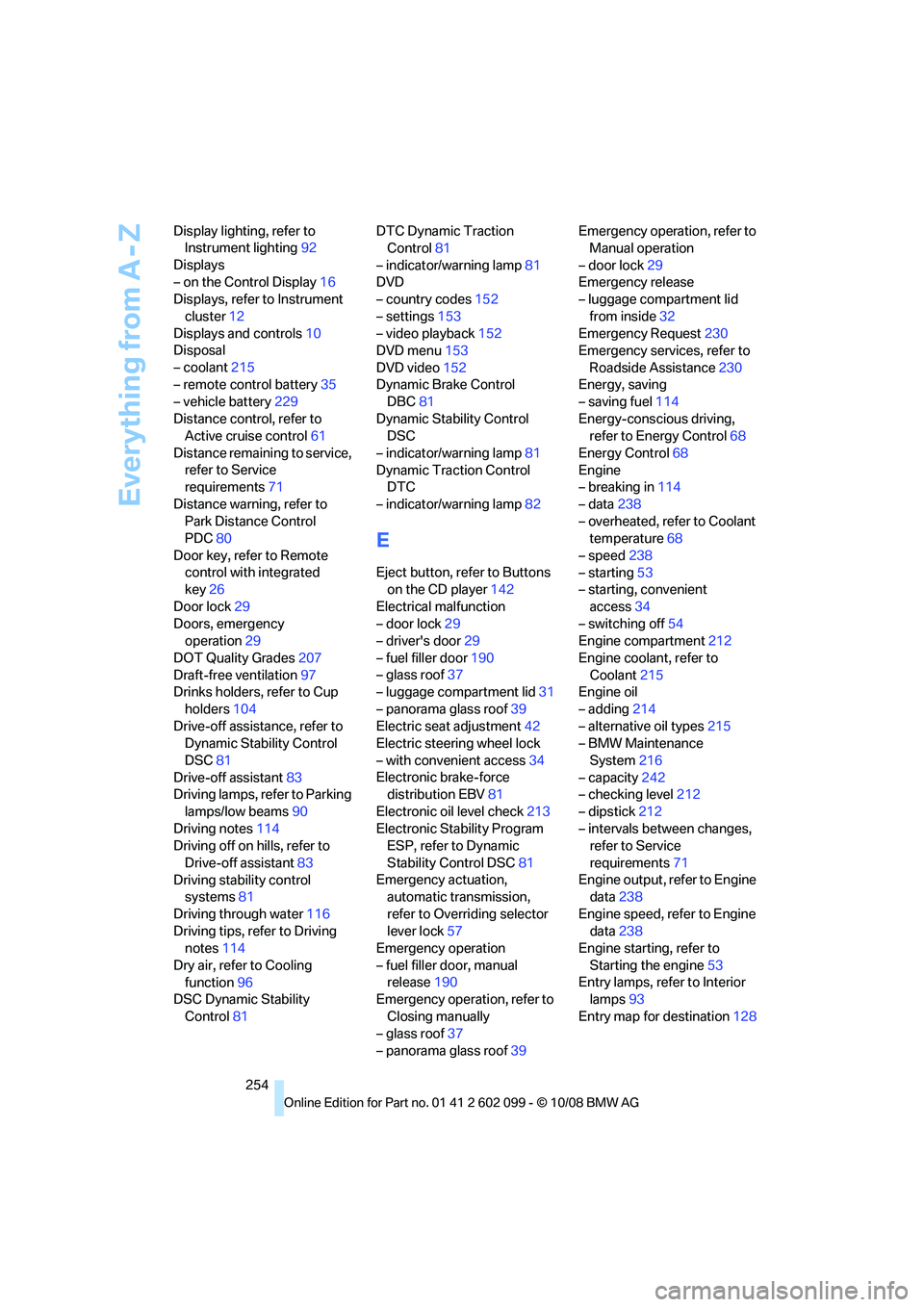
Everything from A - Z
254
Display lighting, refer to
Instrument lighting 92
Displays
– on the Control Display 16
Displays, refer to Instrument
cluster 12
Displays and controls 10
Disposal
– coolant 215
– remote control battery 35
– vehicle battery 229
Distance control, refer to Active cruise control 61
Distance remainin g to service,
refer to Service
requirements 71
Distance warning, refer to Park Distance Control
PDC 80
Door key, refer to Remote control with integrated
key 26
Door lock 29
Doors, emergency operation 29
DOT Quality Grades 207
Draft-free ventilation 97
Drinks holders, refer to Cup
holders 104
Drive-off assistance, refer to Dynamic Stability Control
DSC 81
Drive-off assistant 83
Driving lamps, refer to Parking
lamps/low beams 90
Driving notes 114
Driving off on hills, refer to
Drive-off assistant 83
Driving stability control systems 81
Driving through water 116
Driving tips, refer to Driving notes 114
Dry air, refer to Cooling function 96
DSC Dynamic Stability
Control 81 DTC Dynamic Traction
Control 81
– indicator/warning lamp 81
DVD
– country codes 152
– settings 153
– video playback 152
DVD menu 153
DVD video 152
Dynamic Brake Control DBC 81
Dynamic Stability Control DSC
– indicator/warning lamp 81
Dynamic Traction Control DTC
– indicator/warning lamp 82
E
Eject button, refer to Buttons
on the CD player 142
Electrical malfunction
– door lock 29
– driver's door 29
– fuel filler door 190
– glass roof 37
– luggage compartment lid 31
– panorama glass roof 39
Electric seat adjustment 42
Electric steering wheel lock
– with convenient access 34
Electronic brake-force distribution EBV 81
Electronic oil level check 213
Electronic Stability Program ESP, refer to Dynamic
Stability Control DSC 81
Emergency actuation, automatic transmission,
refer to Overriding selector
lever lock 57
Emergency operation
– fuel filler door, manual release 190
Emergency operation, refer to
Closing manually
– glass roof 37
– panorama glass roof 39Emergency operation, refer to
Manual operation
– door lock 29
Emergency release
– luggage compartment lid
from inside 32
Emergency Request 230
Emergency services, refer to
Roadside Assistance 230
Energy, saving
– saving fuel 114
Energy-conscious driving, refer to Energy Control 68
Energy Control 68
Engine
– breaking in 114
– data 238
– overheated, refer to Coolant temperature 68
– speed 238
– starting 53
– starting, convenient
access 34
– switching off 54
Engine compartment 212
Engine coolant, refer to Coolant 215
Engine oil
– adding 214
– alternative oil types 215
– BMW Maintenance
System 216
– capacity 242
– checking level 212
– dipstick 212
– intervals between changes, refer to Service
re
quirements 71
Engine output, refer to Engine data 238
Engine speed, refer to Engine data 238
Engine starting, refer to
Starting the engine 53
Entry lamps, refer to Interior lamps 93
Entry map for destination 128
ba8_E9091_cic.book Seite 254 Mittwoch, 29. Oktober 2008 2:59 14
Page 258 of 268
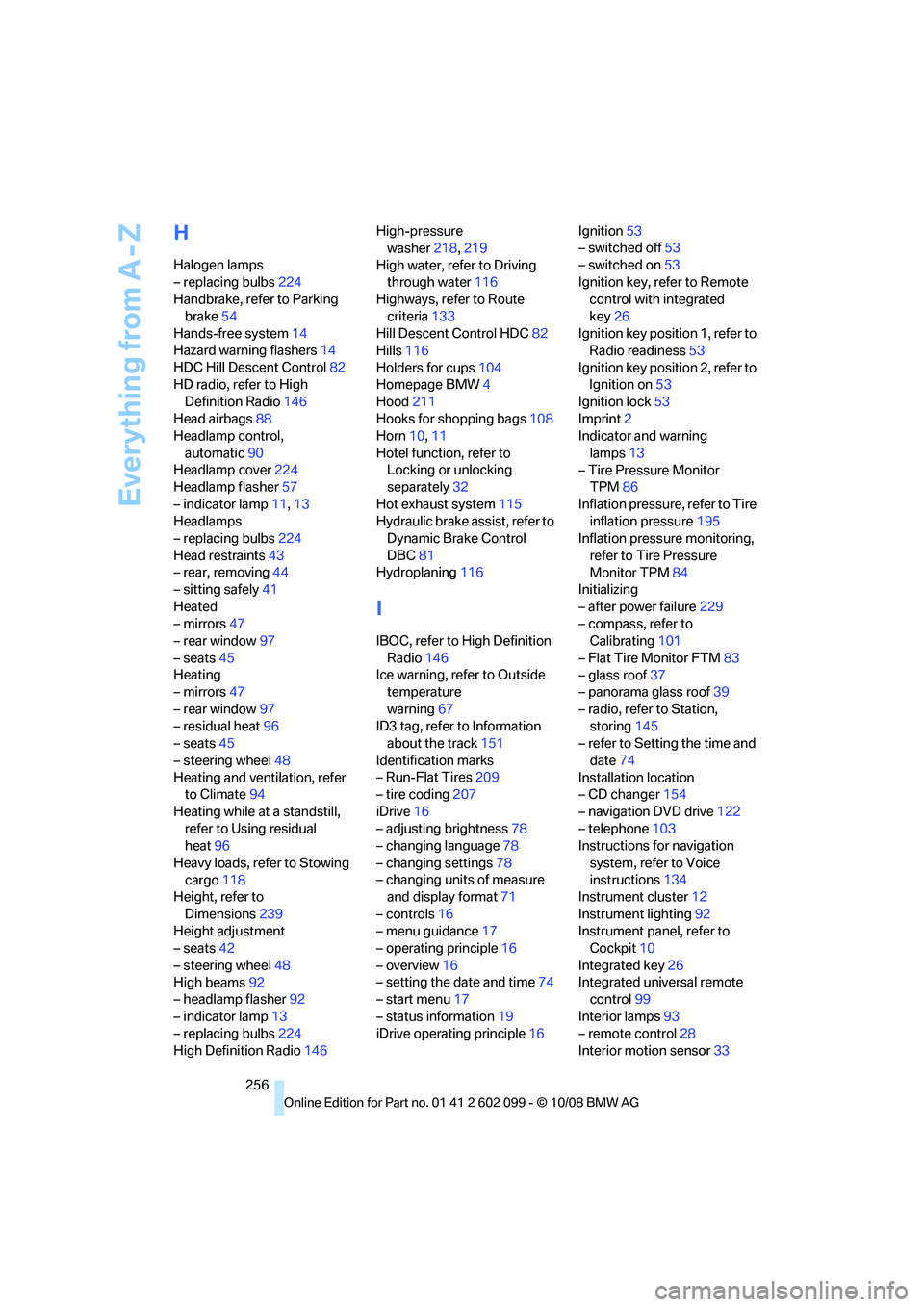
Everything from A - Z
256
H
Halogen lamps
– replacing bulbs224
Handbrake, refer to Parking
brake 54
Hands-free system 14
Hazard warning flashers 14
HDC Hill Descent Control 82
HD radio, refer to High Definition Radio 146
Head airbags 88
Headlamp control,
automatic 90
Headlamp cover 224
Headlamp flasher 57
– indicator lamp 11,13
Headlamps
– replacing bulbs 224
Head restraints 43
– rear, removing 44
– sitting safely 41
Heated
– mirrors 47
– rear window 97
– seats 45
Heating
– mirrors 47
– rear window 97
– residual heat 96
– seats 45
– steering wheel 48
Heating and ventilation, refer to Climate 94
Heating while at a standstill, refer to Using residual
heat 96
Heavy loads, refer to Stowing cargo 118
Height, refer to
Dimensions 239
Height adjustment
– seats 42
– steering wheel 48
High beams 92
– headlamp flasher 92
– indicator lamp 13
– replacing bulbs 224
High Definition Radio 146High-pressure
washer 218,219
High water, refer to Driving through water 116
Highways, refer to Route
criteria 133
Hill Descent Control HDC 82
Hills 116
Holders for cups 104
Homepage BMW 4
Hood 211
Hooks for shopping bags 108
Ho
rn 10, 11
Hotel function, refer to Locking or unlocking
separately 32
Hot exhaust system 115
Hydraulic brake assist, refer to Dynamic Brake Control
DBC 81
Hydroplaning 116
I
IBOC, refer to High Definition
Radio 146
Ice warning, refer to Outside temperature
warning 67
ID3 tag, refer to Information about the track 151
Identification marks
– Run-Flat Tires 209
– tire coding 207
iDrive 16
– adjusting brightness 78
– changing language 78
– changing settings 78
– changing units of measure and display format 71
– controls 16
– menu guidance 17
– operating principle 16
– overview 16
– setting the date and time 74
– start menu 17
– status information 19
iDrive operating principle 16Ignition
53
– switched off 53
– switched on 53
Ignition key, refer to Remote control with integrated
key 26
Ignition key position 1, refer to Radio readiness 53
Ignition key position 2, refer to Ignition on 53
Ignition lock 53
Imprint 2
Indicator and warning
lamps 13
– Tire Pressure Monitor TPM 86
Inflation pressure, refer to Tire inflation pressure 195
Inflation pressure monitoring,
refer to Tire Pressure
Monitor TPM 84
Initializing
– after power failure 229
– compass, refer to Calibrating 101
– Flat Tire Monitor FTM 83
– glass roof 37
– panorama glass roof 39
– radio, refer to Station, storing 145
– refer to Setting the time and
date 74
Installation location
– CD changer 154
– navigation DVD drive 122
– telephone 103
Instructions for navigation
system, refer to Voice
instr
uctions 134
Instrument cluster 12
Instrument lighting 92
Instrument panel, refer to Cockpit 10
Integrated key 26
Integrated universal remote control 99
Interior lamps 93
– remote control 28
Interior motion sensor 33
ba8_E9091_cic.book Seite 256 Mittwoch, 29. Oktober 2008 2:59 14